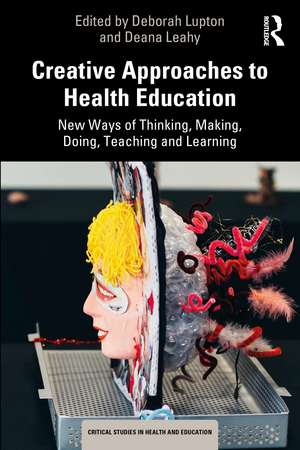Creative Approaches to Health Education: New Ways of Thinking, Making, Doing, Teaching and Learning: Critical Studies in Health and Education
Editat de Deborah Lupton, Deana Leahyen Limba Engleză Paperback – 26 noi 2021
This book shows how creative methods, drawing on innovative arts- and design-based approaches, can be employed in health education contexts. It takes a very broad view of 'health education', considering it as applying not only in school settings but across the lifespan, and as including physical education and sexuality education as well as public health campaigns, health activist initiatives and programs designed for training educators and health professionals.
The chapters outline a series of case studies contributed by leaders in the field, describing projects using a wide variety of creative methods conducted in a variety of global contexts. These include a rich constellation of arts- and design-based methods and artefacts: sculptures, dance, walking and other somatic movement, diaries, paintings, drawings, zines, poems and other creative writing, body maps, collages, stories, films, photographs, theatre performances, soundscapes, potions, rock gardens, brainstorming, debates, secret ballots, murals and graffiti walls. There are no rules or guidelines outlined in these contributions about 'how to do' creative approaches to health education. However, the methods in the case studies the authors describe are explained in detail so that they can be adopted or re-invented in other contexts. More importantly, these contributions provide inspiration. They demonstrate what can be done in the field of health education (however it is defined) to go beyond the often stultifying and conventional boundaries it has set for itself.
Creative Approaches to Health Education demonstrates that creative approaches can be used to inspire those working and teaching in health education and their publics to think and do otherwise as well as advance health education research and pedagogies into new, exciting and provocative directions. It will be of interest to postgraduate students and researchers in education and health-related fields who want to explore and experiment with creative methods and craftivism in applied inquiry.
| Toate formatele și edițiile | Preț | Express |
|---|---|---|
| Paperback (1) | 349.53 lei 6-8 săpt. | |
| Taylor & Francis – 26 noi 2021 | 349.53 lei 6-8 săpt. | |
| Hardback (1) | 1000.27 lei 6-8 săpt. | |
| Taylor & Francis – 26 noi 2021 | 1000.27 lei 6-8 săpt. |
Din seria Critical Studies in Health and Education
-
 Preț: 298.53 lei
Preț: 298.53 lei -
 Preț: 356.18 lei
Preț: 356.18 lei -
 Preț: 354.06 lei
Preț: 354.06 lei -
 Preț: 281.14 lei
Preț: 281.14 lei -
 Preț: 344.36 lei
Preț: 344.36 lei - 18%
 Preț: 1000.27 lei
Preț: 1000.27 lei
Preț: 349.53 lei
Nou
66.90€ • 69.57$ • 55.98£
Carte tipărită la comandă
Livrare economică 15-29 martie
Specificații
ISBN-10: 0367648342
Pagini: 208
Ilustrații: 122
Dimensiuni: 156 x 234 x 11 mm
Greutate: 0.45 kg
Ediția:1
Editura: Taylor & Francis
Colecția Routledge
Seria Critical Studies in Health and Education
Locul publicării:Oxford, United Kingdom
Public țintă
Postgraduate and Undergraduate AdvancedCuprins
Notă biografică
Deana Leahy is Associate Professor in Health Education in the Faculty of Education, Monash University, Melbourne, Australia.
Descriere
This book shows how creative methods, drawing on innovative arts- and design-based approaches, can be employed in health education contexts. It takes a very broad view of 'health education', considering it as applying not only in school settings but across the lifespan, and as including physical education and sexuality education as well as public health campaigns, health activist initiatives and programs designed for training educators and health professionals.
The chapters outline a series of case studies contributed by leaders in the field, describing projects using a wide variety of creative methods conducted in a variety of global contexts. These include a rich constellation of arts- and design-based methods and artefacts: sculptures, dance, walking and other somatic movement, diaries, paintings, drawings, zines, poems and other creative writing, body maps, collages, stories, films, photographs, theatre performances, soundscapes, potions, rock gardens, brainstorming, debates, secret ballots, murals and graffiti walls. There are no rules or guidelines outlined in these contributions about 'how to do' creative approaches to health education. However, the methods in the case studies the authors describe are explained in detail so that they can be adopted or re-invented in other contexts. More importantly, these contributions provide inspiration. They demonstrate what can be done in the field of health education (however it is defined) to go beyond the often stultifying and conventional boundaries it has set for itself.
Creative Approaches to Health Education demonstrates that creative approaches can be used to inspire those working and teaching in health education and their publics to think and do otherwise as well as advance health education research and pedagogies into new, exciting and provocative directions. It will be of interest to postgraduate students and researchers in education and health-related fields who want to explore and experiment with creative methods and craftivism in applied inquiry.
